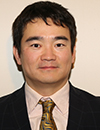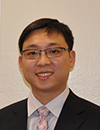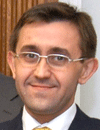Co-Located Conference AgendasFlow Chemistry Asia 2024 | Lab-on-a-Chip, Microfluidics, & Organ-on-a-Chip Asia 2024 | 

Thursday, 7 November 202408:00 | Conference Registration, Materials Pick-Up, Coffee and Networking in the Exhibit Hall (Ozora Banquet Room) | 08:50 | Welcome by the Conference Chairpersons: Professor Paul Watts and Professor Guangsheng Luo | |
Venue: Tsuru B |
| | 09:00 |  | Conference Chair Development of Microreactor Technology: Multiphase Microdispersion, Mass Transfer and Separation Characteristics Under Complex Conditions
Guangsheng Luo, Professor, Tsinghua University, China
The microreactor technologies have provided very high promising capacities in many fields. But they are facing some challenges for their applications in complex conditions, such as high viscosity, high phase or high mixing ratio. New microreactor technologies are high required. This presentation will show some new developments with active microdispersion technology as an examples. The shear forces used for multiphase flow dispersion and enhanced mass transfer in traditional passive microreactors depend on the continuous phase flow rate, leading to significant limitations in their application under complex conditions such as high gas-liquid or liquid-liquid volume ratios and high viscosities. Therefore, we propose the introduction of a rotating flow field in microscale spaces, designing a novel active device—the miniaturized annular rotating device (m-ARD). The m-ARD utilizes a rotating flow field to provide shear forces instead of relying on continuous phase flow rates, achieving efficient mass transfer and separation under high viscosity or large gas-liquid or liquid-liquid volume ratio conditions. |
| 09:30 |  | Keynote Presentation Continuous Flow Reaction for the Synthesis of Fine Chemicals
Shengyang Tao, Dean, Dalian University of Technology, China
Continuous flow chemical reaction is a clean, efficient, and safe synthesis method that has developed in recent years. With this method, researchers can synthesize a variety of high-value-added fine chemicals. This presentation introduces our group's research progress in designing a continuous flow reactor, synthesizing fine chemicals by continuous flow chemical reaction, and optimizing the continuous flow reaction process by artificial intelligence technology. |
| 10:00 |  | Keynote Presentation Recent Progress and Case Studies of Flow Chemistry Technology in Small Molecule API Process R&D and Manufacturing
Chao Liu, Head and Director FEEP Lab, Process Enabling Technology Platform, WuXi STA, China
Introducing recent progress on the application of flow chemistry in the process R&D and manufacturing of small molecular APIs, covering the technical drivers, process concept, and distribution of process types in actual implementations. Some real cases on the scale-up application of photo chemistry, ozonolysis, and carbonylation using CO2, hydrogenation etc. will be presented as well to exemplify achieved process improvements.
|
| 10:30 | Mid-Morning Coffee Break, Networking and Poster Viewing in the Exhibit Hall | 11:00 |  | Keynote Presentation AI-Empowered Flow Chemistry Instrument Manufacturing and Application
Di Sha, Chief Scientist, Ou Shisheng (Beijing) Technology Co. Ltd., China
Since its establishment in 2015, Ou Shisheng (Beijing) Technology Co., Ltd. has cooperated with Professor Guangsheng Luo of Tsinghua University and his research team. Based on microreaction continuous flow chemistry synthesis technology, we have innovatively developed products according to specific chemistry reactions or specific applications in the biology field, including a series of dedicated intelligent equipment, inline detection, sensors and tool-based automation devices, from early research and development in the laboratory to flow chemistry equipment and software for scale-up production. According to the continuity characteristics of flow chemistry, under the premise of the Internet of Things, AI is assisted in early stage of research and development, and the perfect combination of AI and hardware not only greatly improves efficiency, but also accumulates a large amount of real data to provide sufficient data support and guide new product development. At present, we have collaborated with more than 1,000 users in pharmaceutical, CXO, fine chemicals, catalysts, new energy, semiconductor and other industries around the world, including enterprises and scientific research groups in universities. |
| 11:30 |  | Keynote Presentation Controllable Microfluidic Emulsions for Creating Functional Particles
Wei Wang, Professor, School of Chemical Engineering, Sichuan University, China
Emulsion droplets play important roles in template synthesis of functional particles for various fields such as controlled release, catalysis, and separation. The features of emulsion droplets including their size and size distribution, shape, composition, and structure generally determine those features of the resultant particles and their functions for marvelous applications. This presentation introduces our recent works on microfluidic emulsification techniques for controllable emulsion production and functional particle synthesis. First, versatile microfluidic emulsification techniques for controllable generation of emulsion droplets from simple single emulsions to complex multiple emulsions are introduced. Then, rational synthesis of particles with controllable sizes, shapes, compositions, structures, and functions by using controllable emulsion droplets from microfluidics as templates are introduced. |
| 12:00 |  | Keynote Presentation Developing New Microflow Processes Using Classical Reagents
Shinichiro Fuse, Professor, Nagoya University, Japan
Classical electrophiles such as thionyl chloride, phosphorus trichloride, phosphorus tribromide, and triphosgene are useful because they are inexpensive, readily available, less wasteful, and highly active. However, their high electrophilicity often causes undesired reactions. Microflow technology allows precise control of both short reaction time and temperature. Therefore, the combination of microflow technology and classical electrophiles opens the door to developing new useful chemical processes. In this talk, I will introduce our developed microflow synthetic processes that cannot be achieved under conventional batch conditions. |
| 12:30 | Networking Lunch in the Exhibit Hall (Japanese Bento) -- Network with Exhibitors and Colleagues, View Posters | |
Afternoon Session Title: Research Efforts in Flow Chemistry - A Broad Picture of Flow Chem and Its Utility. Session Chairs: Professor Watts and Professor Luo |
| | 14:00 |  | Keynote Presentation Low Cell Voltage Electrosynthesis of Hydrogen Peroxide
Kai Wang, Associate Professor, Department of Chemical Engineering, Tsinghua University, China
Electrochemical oxygen reduction reaction (ORR) via a selective 2e-
pathway offers a great opportunity for the synthesis of hydrogen
peroxide as an alternative of traditional anthraquinone route.
Unfortunately, the cell voltage of hydrogen peroxide electrosynthesis on
neutral condition still requires improvement to meet the industrial
demands, where high productivity and low input energy are desired. In
this report, crucial impacts of reactor component on the relationship of
cell voltage and current density and the over-potentials of each part
of a flow cell reactor for hydrogen peroxide electrosynthesis are
introduced, which indicate that the cathodic solution overpotential has
a great contribution to the cell voltage. When applying thin cathodic
solution channel, the hydrogen peroxide can be synthesized at 2.28 V
cell voltage with 300 mA/cm2 current density and 97.1% Faraday
efficiency, corresponding to an energy consumption of 3.70 kWh/kg H2O2,
which is much lower than the literature results. The produced hydrogen
peroxide can be directly used for synthesizing high purity
2,2'-dibenzothiazole disulfide, showing the potential industrial value
of hydrogen peroxide electrosynthesis technology.
The authors acknowledge the support from National Natural Science
Foundation of China (No. 22178194) and for this work. |
| 14:30 |  | Keynote Presentation Automatic Measurement for Photoreaction Kinetics Based on Single-Liquid-Slug Oscillatory Flow
Fang Zhao, Associate Professor, East China University of Science and Technology, China
An automatic single-liquid-slug oscillatory flow platform was
established for the kinetic investigation of photochemical reactions.
Reaction parameters including concentration, reaction time, light
intensity, pressure, and temperature were controlled precisely in an
automatic manner, and the reaction outcomes were obtained accurately
via, integration of an online HPLC. With the reaction kinetics
measurement performed for the photocatalytic oxidation of citronellol by
Ru(bpy)3Cl2 at a volume scale of 50 µL, it was demonstrated that the
single-liquid-slug oscillatory flow method was capable of achieving
material and time savings of 70% and 38% respectively as compared to the
conventional batch method, and of 80% and 62% respectively as compared
to the continuous flow method. The four reaction orders manifesting the
effects of the substrate concentration, photocatalyst concentration,
light intensity, and oxygen pressure, respectively, were attained as
well as the photoreaction rate constant. Furthermore, the kinetic data
obtained under a series of temperatures also shed light on the
photoreaction mechanism which exhibited a relationship between the
photoreaction rate constant and temperature that deviated from the
Arrhenius law. The approach developed in this work is especially useful
for the kinetic studies of photoreactions with relatively slower
intrinsic reaction kinetics, achieving a more resource-efficient
practice with higher repeatability and accuracy. |
| 15:00 | Sustainable Chemical and Biochemical Processes Through Continuous Synthesis and Separation
Nopphon Weeranoppanant, Associate Professor, Burapha University, Thailand
Conventional chemical processes often involve the use of toxic reagents, high energy consumption, and inefficient step economy, posing sustainability challenges. To address this, our research group employs alternative catalytic systems such as biocatalysis and photocatalysis. Different strategies, including catalyst immobilization and hybrid separation-reaction systems, can be implemented to facilitate catalyst recycling and increase productivity. In this talk, demonstration of such strategies with continuous synthesis and separation will be discussed. | 15:30 | Late Afternoon Coffee and Tea Break in the Exhibit Hall + Poster Viewing | 16:30 | Structured Catalysts for Hydrogenations in Chemical Manufacture and for the Storage of Renewable Hydrogen
Christian Hornung, Research Group Leader, CSIRO, Australia
Over the past 10 years, our group has developed and commercialized a new structured catalyst system, termed Catalytic Static Mixers or CSMs. This technology is based on additively manufactured metal scaffolds which are coated with a noble metal catalyst such as Pt, Pd, Ni, Ru or others. The CSMs are then used inside conventional tubular reactors for continuous flow hydrogenations in chemical manufacturing and for the chemical storage of renewable hydrogen. With the help of computational fluid dynamics and AI-assisted algorithms, the structure of the mixer lattice can be optimized for a range of different outputs, such as minimized pressure drop, maximized heat transfer or enhanced mixing. CSMs are classified as a hierarchical catalyst system, whereby different length scales are addressed by different preparation methods; cm-, mm- and µm-scale features are formed by the powder bed, metal 3D printing process and by classical engineering design of the reactor, while certain µm- and nm-scale features are created during the catalyst preparation and deposition procedures. This results in a highly efficient and versatile catalyst platform which can be used in a broad range of different applications. | 17:00 | Precision Catalysts Technology Spotlight Presentation (Australia) | |
Joint Session -- Flow Chemistry Track and Microfluidics Track Joined Together |
| | |
Venue: Tsuru A and B |
| | 17:30 |  | Conference Chair Has the Flow Changed? From Microfluidic Research to Meso Reactor Synthesis
Paul Watts, Distinguished Professor and Research Chair, Nelson Mandela University, South Africa
When microfluidic reactor technology was first introduced it was seen as being a research and development tool suitable for small scale production, however it is now being used to produce large quantities of product. The key driver in these examples being safety, where the excellent mixing and heat transfer characteristics of micro structured reactors enables these highly exothermic reactions to be safely performed. Nevertheless there is now a plethora of commercial reactors on the market, which means that most companies are investigating this technology to rapidly screen reactions utilising continuous flow, leading to the identification of reaction conditions that are suitable for use at a production level. It is this system flexibility that has the potential to reduce both the time taken and risk associated with transferring reaction methodology from research to production. A selection of reactions demonstrated using this technology will be outlined, which enable local production within Africa. |
| 18:00 | Flow Reactors for Sustainable Colloidal Synthesis of Nanocrystals
Noah Malmstadt, Professor, Mork Family Dept. of Chemical Engineering & Materials Science, University of Southern California, United States of America
Nanocrystal materials including metals, metal carbides and phosphides, and perovskites have broad applications in the transition to sustainable energy. In particular, they can serve as next-generation catalysts for carbon dioxide conversion, fuel cell membranes, and biofuel upgrading. While there are well-established routes to the colloidal synthesis of these materials, they are highly sensitive to local reaction environment, and it has been challenging to scale their production using traditional chemical manufacturing technologies. On the other hand, millifluidic flow reactors, which can deliver excellent reaction environment uniformity, are a promising route to the production of colloidal nanocrystals. Recent work has demonstrated that scaling millifluidic reactors via parallelization can approach industrially relevant product throughput. Flow reactors are also powerful tools for reaction discovery. Here, we present two examples of how flow reactor systems can be used to understand the parameter space of nanocrystal synthesis reactions and identify targeted reaction conditions. The first of these examples is the production of Pt nanoparticles (NPs) in ionic liquids (ILs). Ionic liquid (IL) solvents represent a special class of low-volatility, generally safe solvents that are particularly easy to recycle. While the capacity to produce metallic NPs in ILs has been known for decades, we know little about the mechanism of these reactions and in particular how solvent choice can guide this mechanism. To discover the mechanism of Pt NP fabrication in ILs, we have constructed a flow reactor with in-line spectrophotometric monitoring of the products. To determine reaction component concentration from the complex spectral data, we have implemented a machine learning (ML) algorithm that can determine concentration. By measuring product concentration as a function of residence time, we are able to determine the IL solvent-dependent reaction kinetics. The second example involves synthesizing photoactive perovskite nanocrystals in a parallel flow reactor system. By controlling hydrodynamic resistance across the channel network, we are able to rapidly screen composition space for the reactants. Analyzing these high throughput data with a neural network facilitates the construction of a map between reactant composition space and product crystal phase space, allowing for manufacturing to target a desired product phase. | 18:30 | Networking Reception in the Exhibit Hall with Japanese Beer and Japanese Sake -- Network with Exhibitors, Colleagues and View Posters | 20:00 | Close of Day One of the Conference |
Friday, 8 November 202408:30 | Morning Coffee, Tea and Networking in the Exhibit Hall | |
Introduction to Day Two by Conference Chairpersons -- Overview of the Structure and Programme for Day Two |
| | |
Venue: Tsuru B |
| | 09:00 |  | Keynote Presentation Overcoming Selectivity and Scalability Challenges via Continuous Photochemistry
Marcus Baumann, Assistant Professor, School of Chemistry, University College Dublin, Ireland
In this talk we will highlight recent work from our group showcasing the use of flow photochemistry for reactions that cannot be performed effectively and/or selectively in batch mode. This will include heterogeneous (solid/liquid) photoreactions using a new photo-CSTR module towards unstable pyrazolines, the aerobic photo-oxidation of benzylic substrates using compressed air as well as a series of intricate azaheterocycles that exploit chromoselective transformations of vinyl azides and azirines. Reaction telescoping as well as inline purification strategies will be highlighted along with gram-scale preparations towards selected targets. Overall, this approach offers an improved and potentially greener route towards a variety of valuable chemical building blocks based on exploiting modern flow approaches. |
| 09:30 |  | Keynote Presentation Towards On-Demand Synthesis of Organic Small Molecules Through Advanced Flow Technology
Wu Jie, Associate Professor, Chemistry Department, National University of Singapore, Singapore
On-demand synthesis of complex molecules represents one of the ultimate goals for organic synthesis. In this talk, I will present some of our recent efforts towards this goal employing advanced flow reactors. A circulation flow has been utilized for solid-involved difunctionalization of ethylene. Continuous flow reactors were applied to achieve stepwise on-demand functionalization of multihydrosilanes using neutral eosin Y-based hydrogen atom transfer photocatalysis. An SPS-flow system was employed to enable automated API synthesis that can deliver analogues in an on demand and button-push fashion. |
| 10:00 |  | Keynote Presentation Continuous Flow For Biomass-based Chemicals Production
Christophe Len, Professor, Chimie ParisTech, CNRS, France
The principles of sustainable development, the bio-economy, and the circular economy are increasingly being applied to the synthesis of industrially relevant molecules. In this context, furfural and glycerol, which serve as platform molecules, are the subject of diverse research approaches aimed at improving their conversion into valuable compounds. Given the current momentum in promoting green chemistry for sustainable development, chemists have recently pioneered catalytic reactions utilizing innovative technologies, such as continuous flow processes. This study highlights recent advancements in the continuous production of derivatives obtained from furfural and glycerol. Among the noteworthy molecules of interest are furfuryl alcohol, levulinic acid and its esters, gamma valerolactone, acrolein, quinoline-type derivatives, solketal, triacetin, and glycerol oligomers. These derivatives are synthesized from biomass or carbohydrates, utilizing both homogeneous and heterogeneous catalysts. Various reaction parameters, including temperature, catalyst and feedstock loadings, and solvent types, have been meticulously fine-tuned with a focus on time efficiency. The conceptualization, synthesis, and detailed examination of the physicochemical properties of these derivatives will be comprehensively addressed. |
| 10:30 | Mid-Morning Coffee Break and Networking in the Exhibit Hall | 11:00 | Product Presentation by Precision Catalysts (Australia) | 11:30 | Pickering Emulsion Enhanced Interfacial Catalysis Under Taylor Flow in a Microchannel Reactor
Yuchao Zhao, Professor, Yantai University, China
The fouling and clogging of microchannels caused by solid particles hinder the application of microchannel reactors for multiphase catalytic reactions involving solid particles. For solving these problems, the novel method based on the Pickering emulsion was proposed and systematically investigated in this study. Stable Pickering emulsions were prepared by using the surface modified SiO2 nanoparticle as a stabilizer. | 12:00 | Presentation by Asymchem Labs, China.
Tao Jian, Vice President and Head of Center of Flow & Continuous Technology (CFCT), Asymchem, China
| 12:30 | Networking Lunch in the Exhibit Hall (Japanese Bento) -- Network with Exhibitors and Colleagues, View Posters | |
Afternoon Late-Breaking Session Chaired by Professor Paul Watts |
| | |
Venue: Tsuru B |
| | 14:00 |  | Keynote Presentation Microfluidics (within small Batches) at New Frontiers: Under Plasma and Reduced Gravity
Volker Hessel, Professor,, The University of Adelaide, Australia
With >30 years research in microreactors/microfluidics and >20 years research in flow chemistry, the topic is able to release new innovation potential by bridging the topic cross-disciplinary to other emerging fields of ‘younger age’ with high innovation revolving. First example is a plasma microjet, deeply penetrating a liquid microvolume, to create a thin stagnant liquid layer with large interface. This ‘in-situ microreactor’ achieves greatly enhanced reaction rate. Energy-wise the new process is within best plasma processes and better thanflow chemistry processes. Second example is a gas-liquid plasma reactor that generates micro-bubbles through micro-orifices after passing the electrodes. The bubbles can be tailored by adjusting physical (e.g., surface tension) and plasma (e.g., voltage) parameters. That is key to generating nitrogen fertilizer from air or artificial urine. Last and third example are (microfluidically-made) nanoemulsions as nanofood- and nanomedicine carriers for astronauts in space habitats. The determination of the rheological and fluidical behavior of the nanodroplets, under Earth-simulated reduced gravity conditions, answered the question when does true micro/moon/Mars gravity act and when the experiment is falsified by shear forces. |
| 14:30 | Title to be Confirmed
Shusaku Asano, Assistant Professor, Kyushu University, Japan
| 15:00 | Late-Afternoon Coffee Break and Networking in the Exhibit Hall + Poster Viewing -- Discussions in the Exhibit Hall Continue |
|


 Add to Calendar ▼2024-11-07 00:00:002024-11-08 00:00:00Europe/LondonFlow Chemistry Asia 2024Flow Chemistry Asia 2024 in Tokyo, JapanTokyo, JapanSELECTBIOenquiries@selectbiosciences.com
Add to Calendar ▼2024-11-07 00:00:002024-11-08 00:00:00Europe/LondonFlow Chemistry Asia 2024Flow Chemistry Asia 2024 in Tokyo, JapanTokyo, JapanSELECTBIOenquiries@selectbiosciences.com